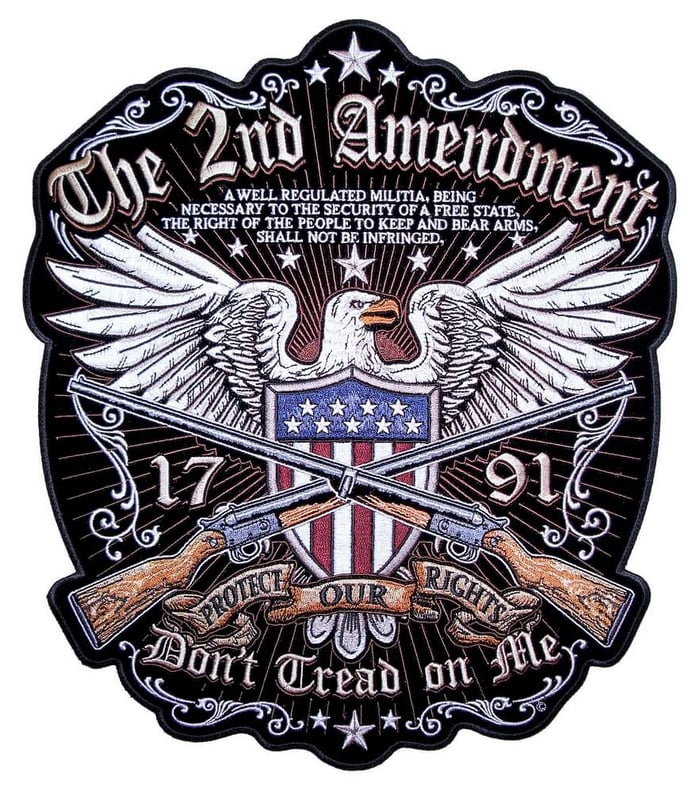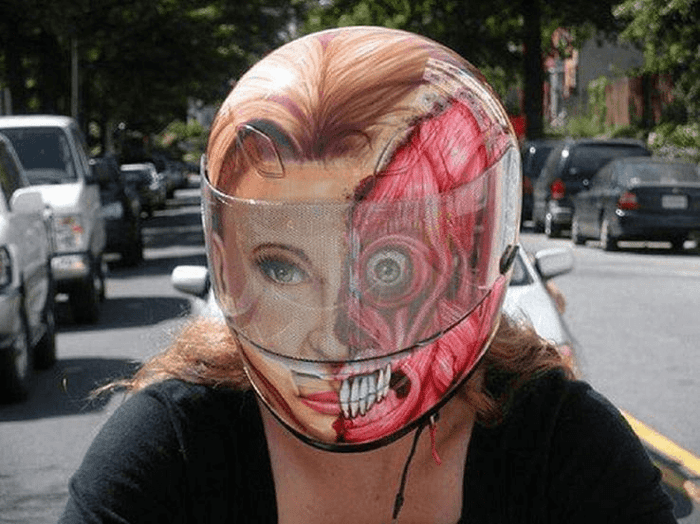The culture of bikers is fundamentally based on patches. Biker club or association patches are displayed on their jackets or vests by bikers. The biking community holds these patches, also referred to as "colors," in high regard and regards them as a badge of pride and honor.
Biker patches are the patches that bikers wear on their vests or jackets. These patches can have small, straightforward designs or bigger, more intricate ones, and they frequently serve to represent the club or association that the biker is a member of. They can also be used to highlight a biker's accomplishments, like finishing a long ride or belonging to a particular club or organization.
The biker community places a high value on motocross patches. They are regarded as a source of pride and honor as well as a means by which bikers can relate to one another. Additionally, these patches allow bikers to show their allegiance to their club or association and to establish their position within the group.
Additionally, biker patches are frequently used to highlight a biker's background and professional achievements. A patch with the number "1" on it, for instance, denotes that the rider is a part of the club's leadership, whereas a patch bearing a skull and crossbones denotes that the rider has been in a terrible accident.
When American motorcycle organizations first started to form in the early 1900s, patches became a common part of biker culture. These patches, which at the time were frequently worn on the backs of motorcycle jackets, served as a symbol of a biker's membership in a specific club.
Biker patches were widely worn when motorcycle culture became increasingly popular in the 1950s. Motorcycle clubs started using more detailed patterns for their patches around this time, frequently including elaborate motifs and symbols.
The use of patches also increased in popularity during the 1960s as motorcycle culture spread. Patches were frequently used to signify a biker's position inside these groups at this time, which was also when biker gangs started to become more well-known in the media.
Biker patches are still a crucial component of biker culture today, and many organizations and organisations create unique patches to symbolize their beliefs and principles.
Biker patches are an important component of biker culture, standing for pride, honor, and allegiance among the group. They enable bikers to connect with one another, celebrate their achievements, and establish their position within their club or group. About a century ago, patches were first used in motorcycle culture, and they are still a crucial part of the biker way of life today.
Biker patches currently exist in a variety of designs, from classic club colors to more contemporary and artistic ones. This is because they have developed over time. Some biker patches are also worn to support a cause or bring attention to societal problems.
Biker patches are important to the motorcycle community, but they are also becoming more common in mainstream fashion. Many people, including those who don't ride motorbikes, don vests or jackets with biker patches to show off their attitude or sense of fashion.
It's crucial to remember nevertheless that not all fixes are created equal. Outlaw motorcycle gangs (OMGs), which engage in illicit activities like drug trafficking and extortion, may be represented by some patches. These patches should not be worn by law-abiding riders because they are frequently connected to violence and criminal activity.
A key component of biker culture is the use of patches to identify a rider's club, association, or personal convictions. These patches serve as a means of identification for motorcyclists as well as a source of pride and dignity. There are many different kinds of biker patches on the market, and each has a certain meaning and function. We'll go through some of the most well-liked biker patch types in this article.
Club Patches
The most recognizable kind of biker patch is the club patch, sometimes called a color. These patches, which serve to identify the wearer as a member of a certain group, are generally worn by participants in motorcycle clubs or groups. On the back of a biker's jacket or vest, club patches can be seen. They are frequently worn with other kinds of patches, such as rocker patches and rank patches.
A club patch may incorporate the name of the club or a symbol connected to the club's philosophy, and its design often symbolizes the club's ideals and beliefs. Several clubs may include their location or chapter in the patch's design. Club patches may be made of embroidered fabric, leather, or PVC and feature straightforward or elaborate designs.
The respect and reverence that club patches stand for in the biker community is one of their most important characteristics. A club's members are required to proudly display its colors and protect its reputation at all costs. Club members can identify with one another by wearing club patches, which are a sign of devotion and fraternity.
It's important to note that not all "one-percenters" or outlaw motorcycle clubs (OMCs) wear club patches. These patches are often worn by law-abiding riders who share a love or interest in motorcycles. Some riding clubs and groups also have their own club patches.
The values and principles of a specific club or group are represented through club patches, which are a crucial component of biker culture. These patches are a symbol of brotherhood, loyalty, and respect, and are worn with pride by members of a club. Wearing a club patch is a way to demonstrate your commitment to the biker lifestyle and the principles it stands for, whether you are a member of a traditional motorcycle club or a riding organization.
Rocker Patches
Biker patches called rocker patches are frequently sewn at the top and bottom of club patches. These patches are frequently used to display the club name or the chapter's location. For illustration, a rocker patch might say "New York City" or "Los Angeles Chapter."
In order to fit the curves of the jacket or vest where they are worn, rocker patches are often curved in design. Usually, they use complementary colors and fonts that blend nicely with the club patch's design. Rocker patches can be manufactured from a variety of materials, including leather or embroidered cloth.
Rocker patches are used to share more details about the club and its members. Rocker patches can serve as both a club identifier and a chapter of the club's location. Those riders who are trying to get in touch with local groups or who want to go to rides and activities in a specific area might find this information useful.
Rocker patches are not just for club patches, it should be noted. They can also be used to distinguish between different kinds of patches, such event or custom patches. As an illustration, a patch for an occasion might have the name of the occasion on a rocker patch and the occasion's year and place on the primary patch.
Rank Patches
Rank patches are embroidered emblems worn on the shoulders of military uniforms to signify a soldier's rank or position. They are sometimes referred to as military rank patches or shoulder patches. A symbol that denotes the wearer's status, such as an eagle, star, or chevron, is frequently incorporated into patch designs.
The use of rank patches in the American military dates back to the Civil War, when officers started donning embroidered shoulder straps to represent their rank. For enlisted soldiers, the Army introduced a uniform system of rank patches in 1881, with the style differing according to the branch of duty.
Rank patches are still in use by militaries today, albeit they differ in terms of meaning and style. Patches can be used to identify a soldier's branch of service, unit, or unique skills in addition to rank.
In accordance with uniform placement standards, rank patches are normally worn on the upper sleeve of clothing. The placement of the patch varies based on the branch of service and the military, with certain branches angling it slightly to make it easier to recognize.
Rank patches not only serve the practical function of designating rank and position, but they also represent the military and its principles. The colors and emblems of the soldier's unit or branch of duty, as well as patriotic symbolism, are frequently incorporated into the patch's design.
Ultimately, rank patches serve as an iconic and significant representation of the military, as well as the men and women who serve. They help to foster a sense of cohesion and pride among the soldiers in a military unit by identifying and honoring the contributions and accomplishments of military people.
Event Patches
Event patches are a unique kind of biker patch made to honor a certain occasion, such a rally or ride. Riders who have taken part in the event frequently wear these patches as a reminder of the experience.
The name of the event, the year it took place, and any other pertinent details, like the event's location or theme, are frequently included in the design of event patches. They might also include a logo or picture that depicts the occasion, like a motorcycle or a well-known local location.
Embroidered fabric, PVC, leather, and other materials can all be used to create event patches. They can be swapped or sold among riders who attend related events, and they are frequently made to be collectibles. Some riders even keep track of their adventures and the areas they have been by collecting event patches.
The sense of community that event patches evoke is among their most important features. Wearing an event patch can help riders stand out as members of a group of people who are passionate about riding motorbikes and seeing new places. The sharing of the experience of participating in a rally or ride can be celebrated by exchanging event patches with other riders.
In conclusion, event patches are a significant category of biker patches that serve as a reminder of a certain occasion. The name, year, and location of the event, as well as any pertinent visuals or imagery, are all included in the design of these patches, which are normally worn by riders who have taken part in the event. Several materials can be used to create event patches, which are frequently collected. They stand for a sense of belonging and teamwork among riders who have a similar love of motorcycling and the open road.
Personal Patches
Biker patches of the personal variety, often called custom patches, are made specifically for the person wearing them. These patches are frequently used to exhibit individuality and creativity and can be created to reflect the rider's personality, interests, or views.
Personal patches can be created with a variety of graphics, photos, and text and can be fashioned from a variety of materials, including leather or embroidered cloth. Some riders prefer to design unique customized patches that showcase their passion for motorbikes or their preferred motorcycle brand, while others could design patches with their favorite quotes or sayings.
Personal patches can also be used to remember dearly departed family members or to mark important milestones in life. A rider might decide to create a patch, for instance, to honor a friend or relative who has died away or to commemorate a special accomplishment, like finishing a lengthy ride.
Personal patches' ability to let riders show their uniqueness and creativity is one of its most important features. Personal patches can be a method to display that personality and to connect with other like-minded riders. Bikers are frequently recognized for their distinctive style and way of life.
Military Patches
Military personnel wear embroidered patches on their uniforms to identify their branch of service, unit, and rank. These patches are also referred to as unit patches or insignia. They provide as a channel for conveying significant details about a soldier's persona, background, and accomplishments.
Military patches were first worn by American service members during the First World War to identify their division and regiment. Later, during World War II, the wearing of patches became standardized, and it has remained a significant aspect of military culture ever since.
Depending on the wearer's branch of duty, unit, and rank, military patches can have a broad variety of designs, hues, and symbols. The American flag and the colors and insignia of the soldier's unit or branch of duty are frequently incorporated into the patch design.
Military patches might display a soldier's rank, specialization, or credentials in addition to their branch of service and unit. A soldier might display a patch on their uniform designating them as a sniper, medic, or paratrooper, for instance.
Military patches are always worn on the upper sleeve of the uniform, and their location is specified. The placement of the patch varies according on the uniform style and branch of service, with some patches being positioned at an angle to aid in recognition.
In general, military patches are a significant representation of the military and its principles. They help to foster a sense of cohesion and pride among the soldiers in a military unit by identifying and honoring the contributions and accomplishments of military people. They are frequently appreciated as a reminder of a soldier's service and sacrifice and play a significant role in military culture and tradition.
Religious Patches
Religious patches are stitched or woven items with symbols or patterns associated with a particular religion. These patches can be worn on clothing, bags, hats, or other accessories to show off one's spirituality or religious beliefs.
Depending on the particular religion or denomination, religious patches can include a wide range of symbols and designs. Christian patches, for instance, might have crosses, doves, or pictures of Mary or Jesus. Hebrew writing or the Star of David may be seen on Jewish patches. The crescent moon, star, or the Arabic-scripted word of Allah may appear on Islamic patches.
Religious patches may include inspirational or motivating text in addition to specific religious symbols that are connected to faith or spirituality. These messages might be as simple as the words "faith" or "belief" or as complicated as lengthy chapters from sacred texts.
Religious patches can be worn for a variety of reasons. They serve as a platform for certain people to publicly declare their religious convictions and demonstrate support for those who hold similar convictions. Others may use them to commemorate important events like religious festivals or pilgrimages. Members of religious organizations or groups may also wear religious patches to identify themselves to others.
Flag Patches
Flag patches are stitched items that feature the national or organizational flag. As a way to express pride in and identity as a country, they are frequently worn on the uniforms of military members, law enforcement officials, and athletes.
Flag patches are normally created from strong, high-quality materials that can survive continuous use. Depending on the intended application and the consistent design, they can be made in a wide variety of sizes, shapes, and colors.
Military and law enforcement professionals in the United States frequently wear flag patches on their uniforms to show their allegiance to the nation and dedication to defending its citizens. The patch is worn normally on the right shoulder and has a set location on the uniform.
Athletes who compete for their nation in international events like the Olympics or the World Cup may also don flag patches. In these situations, the flag patch represents national pride and identifies the athlete's home country.
Flag patches can stand in for organizations or causes in addition to nations. For instance, those taking part in international peacekeeping missions frequently wear the United Nations flag patch, while those supporting the LGBTQ+ community frequently wear the rainbow flag patch.
Each style and design of motorcycle patch has a specific meaning and function. Every patch, whether it be a club patch or a personal patch, has a special meaning in the biker community. There is a biker patch that can symbolize your values, views, and hobbies whether you ride with a group or alone. With the help of this thorough guide, you can now select the ideal biker patch to reflect your sense of fashion and riding individuality.
Members of motorcycle clubs and other groups wear motocross patches to show their membership in those organizations. These patches have long been seen as symbols of the motorcycle culture. These patches can have a variety of patterns and symbols and are frequently embroidered or sewed onto a vest or jacket. Patch etiquette and protocol, which governs how biker patches should be displayed and used, are a collection of conventions and traditions.
Respecting patch holders is one of the main tenets of patch etiquette. It entails recognizing and respecting their place within the group or organization. Many times, those who wear patches have worked hard to acquire them over many years of service, and they have great significance and worth. Recognizing this is crucial, and you should treat them with the decency and respect they merit.
Knowing the significance of various patches and symbols is a crucial part of patch etiquette. It is significant to understand that, depending on the club or organization, not all patches and insignia are the same and may have distinct meanings.
A patch with a 1% emblem, for instance, might signify membership in an outlaw motorcycle group known as the 1%. Similar to this, the significance of a patch with the Confederate flag may vary depending on the situation and the wearer. It's critical to comprehend these significances and to honor the symbolism.
There are various etiquette guidelines to remember when engaging with bikers who are wearing patches. Avoid touching or grasping a patch holder's patch without their consent as this could be construed as rude or even a breach of their personal space.
Also, it's crucial to avoid looking or ogling at someone's patches because doing so could be interpreted as impolite or hostile. Instead, it is preferable to approach patch owners respectfully and strike up a dialogue in a warm and welcoming manner.
There are also a number of guidelines and traditions to observe when displaying patches. For instance, wearing one's own patches on the back of a vest or jacket rather than the front or sleeves is often regarded as being respectful. Also, it's crucial to refrain from wearing patches that one is not entitled to or has not earned because doing so could be viewed as rude and could lead to a confrontation with other bikers.















